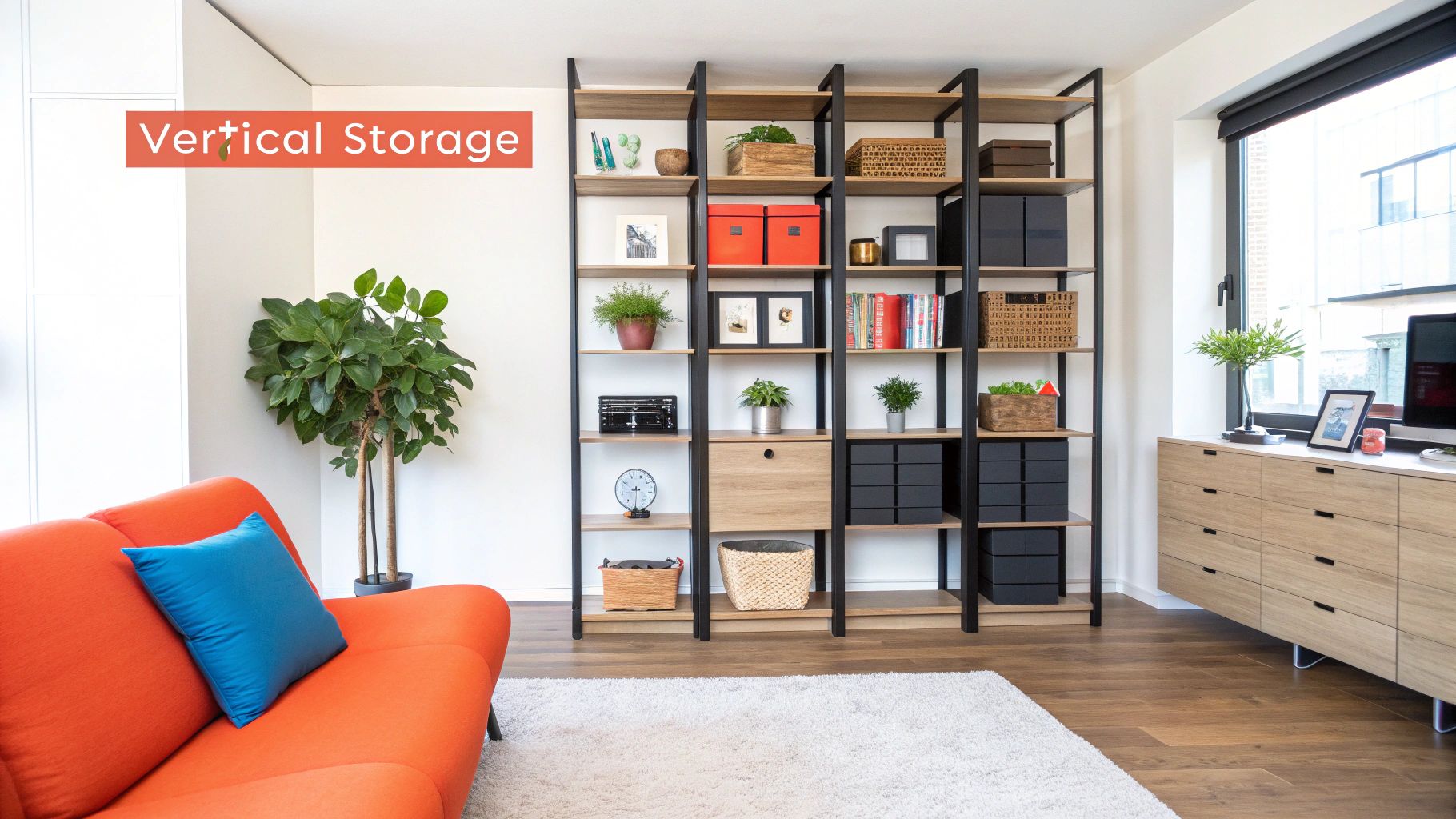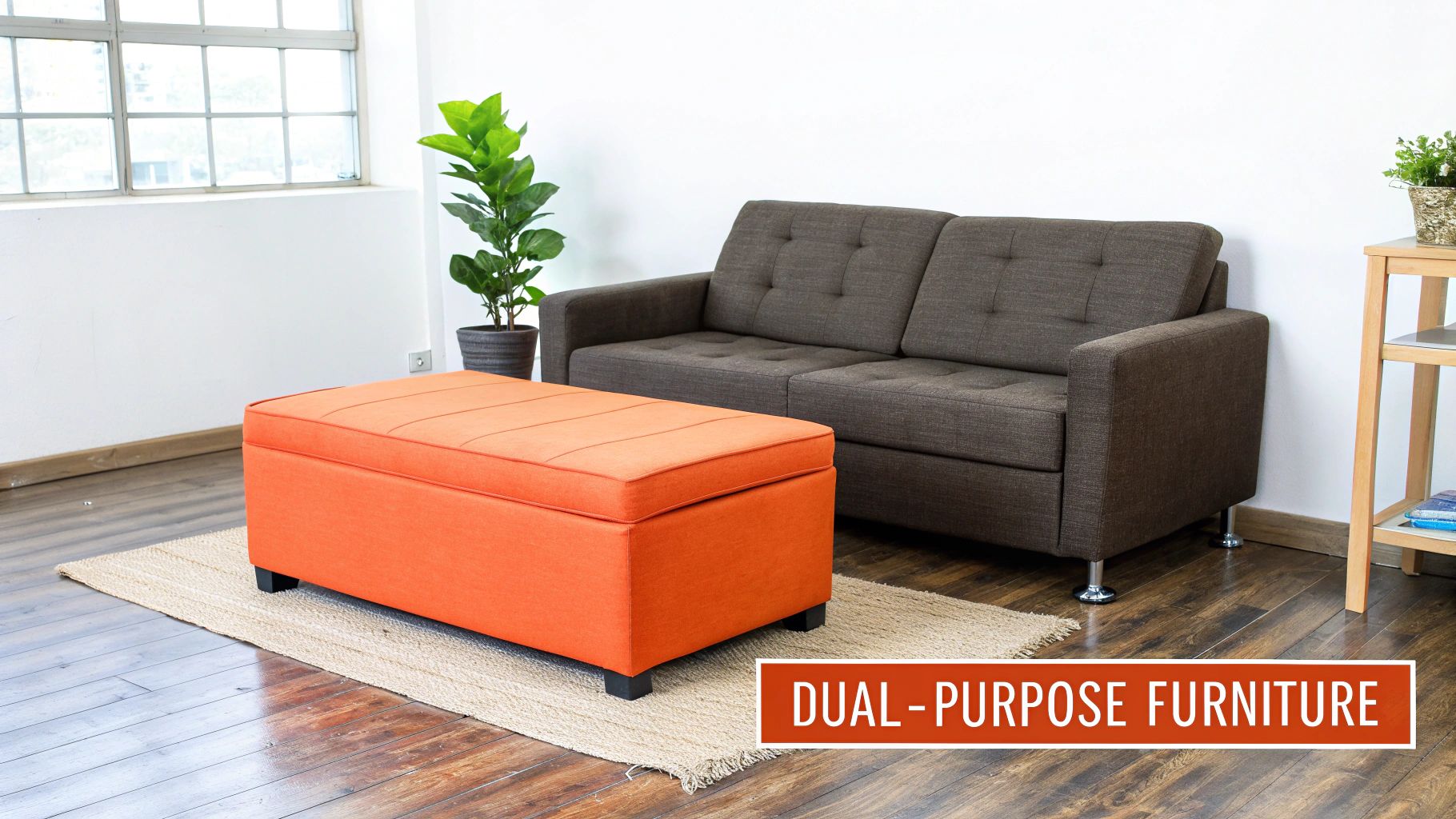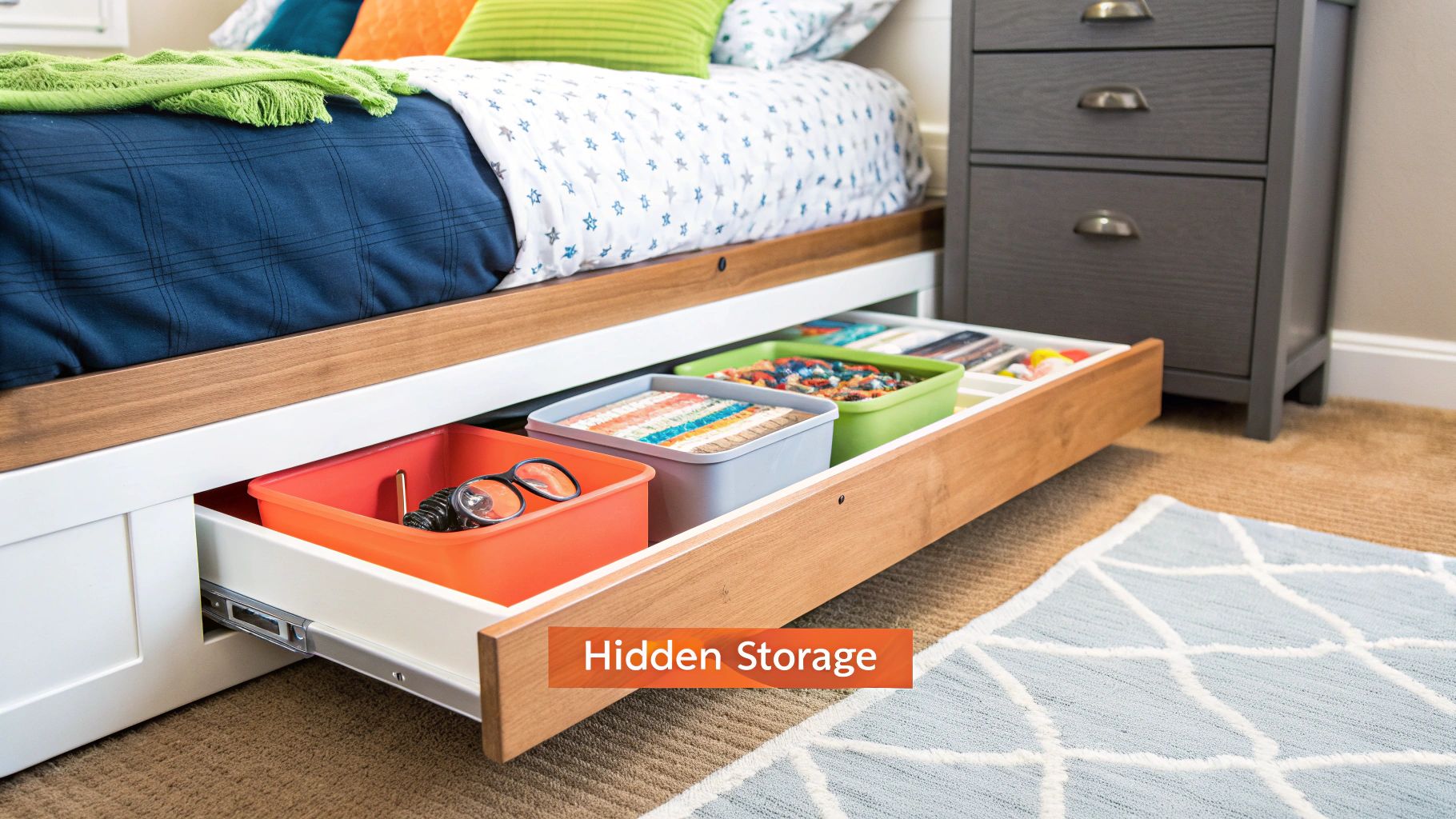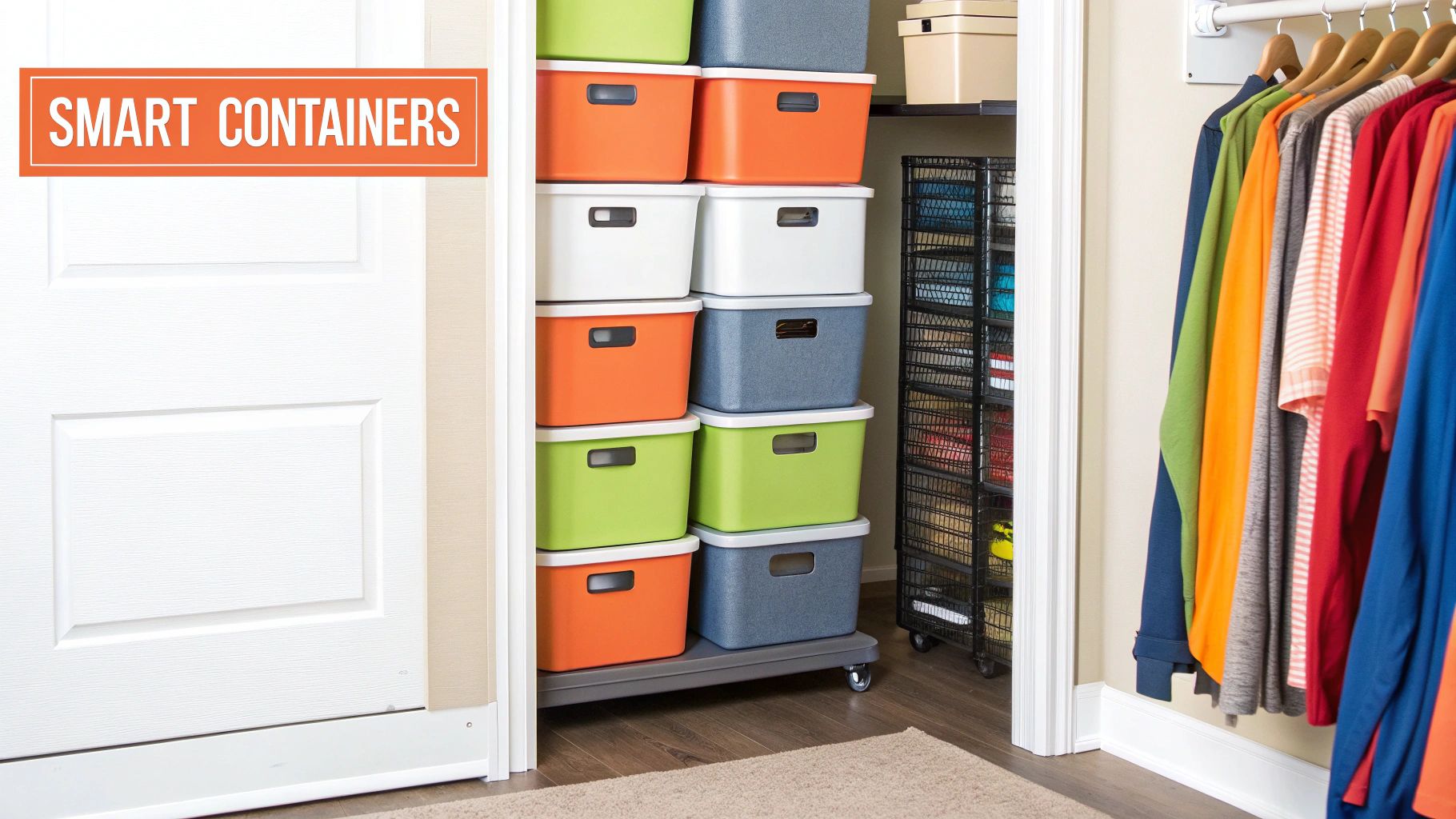-
CALL US:
- (866) 952-3456
Living in a small apartment presents a unique challenge: balancing comfort, function, and style within limited square footage. The constant battle against clutter can feel overwhelming, turning your cozy haven into a source of stress. But what if you could transform your compact space into an organized, serene, and highly functional home? Effective organization is more than just buying storage bins; it's a strategic approach to maximizing every inch. This guide moves beyond the obvious advice, offering eight powerful, actionable strategies for organizing small apartments.
We'll explore innovative ways to utilize vertical space, select smarter furniture, and implement systems that keep clutter at bay for good. These aren't just tips; they're transformative principles that help you create a space that feels larger, breathes easier, and works perfectly for your lifestyle. The goal is to make your home not only look better but feel better, adding beauty and purpose to every corner. For those looking to truly enhance their small living space, even consider the benefits of creating a thriving herb garden for apartment living that blends aesthetics with utility. By the end of this guide, you will have a clear roadmap to conquer the chaos and truly love your small-space living.
When floor space is at a premium, the only direction to go is up. Maximizing vertical storage is a foundational principle for organizing small apartments, transforming unused wall space into highly efficient storage real estate. This strategy involves using the full height of your walls, from floor to ceiling, to keep items organized and accessible without cluttering your limited living area.

This approach draws the eye upward, creating an illusion of a larger, more open room while keeping floors clear for movement and furniture. It’s a game-changer for anyone feeling boxed in by their belongings.
Successfully going vertical requires more than just adding a single shelf. Think in terms of complete systems that cover a significant portion of a wall. Modular systems like IKEA's ALGOT or The Container Store's Elfa are famously effective in tiny studios, allowing you to customize shelves, drawers, and hanging rods to fit your specific needs. Even the back of a door can become a storage powerhouse with an over-the-door organizer for shoes, toiletries, or cleaning supplies.
To get the most out of your walls, follow these practical steps:
By shifting your storage focus from horizontal to vertical, you reclaim valuable floor space and create a more functional and organized home. To explore more in-depth options, you can get additional inspiration for storage solutions for small spaces on assemblysmart.com.
In a small apartment, every piece of furniture must earn its keep. Selecting multi-functional furniture is a cornerstone strategy for organizing small apartments, as it allows you to get maximum utility from minimum square footage. This approach involves choosing smart, adaptable pieces that serve two or more purposes, effectively reducing clutter by eliminating the need for separate, single-use items.

This method ensures your space can transform to meet different needs throughout the day, from a productive home office to a cozy living room or a welcoming dining area. It's about making your furniture work harder so your apartment feels more spacious and functional.
Embracing this philosophy means looking for hidden potential in everyday items. Think of a storage ottoman that serves as a coffee table, extra seating, and a discrete place to store blankets or board games. Brands like Resource Furniture have pioneered this concept with transforming pieces like wall beds that fold away to reveal a desk or sofa, a common sight in NYC micro-units. Similarly, expandable dining tables from stores like CB2 allow urban loft dwellers to host dinner parties without sacrificing daily living space.
To make the best choices for your space, consider these practical tips:
Every small apartment has hidden pockets of potential: the awkward corner, the gap under the bed, or the empty space beneath the stairs. Under-utilized space optimization is the art of identifying these forgotten zones and transforming them into valuable, functional storage. This strategy moves beyond standard furniture and focuses on reclaiming every possible inch.

This approach is crucial for organizing small apartments because it creates storage out of thin air, integrating it seamlessly into your home’s existing architecture without sacrificing floor space or visual flow.
Begin by walking through your apartment and looking for any empty or awkward areas. The space under your bed is a prime candidate, as is the void beneath a staircase or a narrow gap between a cabinet and the wall. Think like a minimalist designer, where every element must have a purpose. In a San Francisco studio, this might mean a bed on risers with designated clothing storage containers beneath. In a Brooklyn brownstone, it could be a custom pull-out pantry built into the space under the stairs.
To effectively reclaim these areas, consider the following practical steps:
By identifying and repurposing these overlooked spots, you add layers of discreet storage, keeping your main living areas open and free of clutter.
The most effective way to create space in a small apartment is to own less stuff. Decluttering and minimizing possessions is a foundational strategy that goes beyond simple tidying; it involves systematically reducing your belongings to only those that are essential, useful, or bring you genuine joy. This creates more physical room and promotes a sense of mental clarity and calm.

This philosophy, popularized by figures like Marie Kondo and The Minimalists, transforms organizing small apartments from a constant battle against clutter into a sustainable lifestyle. By being mindful about what you keep and what you acquire, you prevent accumulation at the source.
A successful decluttering journey is a marathon, not a sprint. The key is a systematic approach rather than a frantic, one-time purge. Start by focusing on one category at a time, such as clothes, books, or kitchen gadgets, to avoid feeling overwhelmed. As you go through each item, ask yourself critical questions: Is this useful? Have I used it in the last year? Does it make me happy? This process helps you make intentional decisions about what truly deserves a place in your home.
To effectively reduce your possessions and maintain a clutter-free space, try these proven methods:
By consciously curating your belongings, you make organizing your apartment significantly easier. This mindset is also incredibly helpful when preparing for a move, and you can get more expert advice on how to sort your belongings before a move from Assembly Smart.
In a small apartment, especially a studio or one with an open floor plan, rooms often have to serve multiple purposes. A zone-based organization system creates clear, functional areas for different activities, preventing your living room from becoming a chaotic mix of work, dining, and relaxation. This method involves creating designated zones and storing all related items within that specific area, bringing order and efficiency to your space.
This strategic division helps maintain mental and physical boundaries, making your home feel more structured and less cluttered. It’s a powerful approach for organizing small apartments where every square foot must be optimized for a specific purpose.
Implementing zones doesn't require physical walls. You can use furniture, rugs, and even lighting to visually and functionally separate one area from another. For example, a sleek console table behind a sofa can create a subtle division between the living area and a small home office. An entryway zone can be established with just a wall-mounted coat rack, a slim shoe cabinet, and a small key tray, corralling clutter right at the door.
To effectively divide and conquer your space, apply these practical strategies:
By creating distinct zones, you give every item and activity a proper home, which is fundamental to successful long-term organization in a compact living environment. For more ideas on defining spaces, explore small apartment layout tips on apartmenttherapy.com.
Implementing a coordinated system of storage containers is a cornerstone of organizing small apartments effectively. This approach moves beyond randomly buying bins and instead focuses on creating a uniform, cohesive system where containers work together to maximize space. By selecting modular, stackable, and often clear containers, you can conquer clutter in closets, under beds, and on shelves with precision.
This method creates visual harmony, which makes a small space feel less chaotic and more intentional. It's the secret behind the hyper-organized pantries and closets you see in magazines, made accessible for any small home.
The key is to think of containers as a single, apartment-wide solution rather than a one-off purchase for a specific problem area. Look to systems where different sizes are designed to stack and fit together seamlessly. For example, Muji's polypropylene boxes are famous in Japanese micro-apartments for their clean look and modularity, while IKEA's SAMLA series offers a budget-friendly way to systematize storage from the attic to the closet. These systems allow you to create neat, stable stacks that make the most of every inch.
To build an effective system that lasts, follow these practical steps:
Open-plan layouts are common in small apartments, but they often lack the distinct functional zones needed for a truly organized life. Flexible room dividers allow you to create separate areas for sleeping, working, or dining without resorting to permanent, costly construction. This strategy provides privacy and organization while maintaining the ability to reconfigure the space as your needs change.
This approach brings structure and order to a studio or loft, making a single room feel like a multi-room home. It's a key tactic for organizing small apartments where one space must serve multiple purposes.
Implementation can range from simple fabric solutions to more structural furniture pieces. A popular method, seen in many industrial lofts, involves using curtains hung from ceiling tracks or industrial pipes to cordon off a bedroom area. For a dual-purpose solution, a tall, open-backed bookcase like IKEA's KALLAX can divide a room while providing valuable storage. Even traditional Japanese shoji screens can add an elegant, lightweight partition. For those looking for more permanent but still flexible options, understanding the pros and cons of space-saving sliding door solutions can help you decide if they're right for your home.
To effectively partition your apartment, consider these practical steps:
By strategically dividing your space, you create dedicated zones that reduce visual clutter and improve the overall flow and organization of your small apartment.
In a small apartment, accessible storage is prime real estate. A seasonal rotation strategy is a systematic approach to reclaiming this valuable space by storing off-season items out of sight and keeping only what you currently need within easy reach. This declutters your immediate living area and simplifies your daily routines.
This method ensures your closet isn't bursting with bulky winter coats in July or that your beach towels aren't taking up shelf space in December. It’s an essential practice for anyone looking to make organizing small apartments a manageable, year-round habit rather than a chaotic annual event.
Implementing this strategy means designating your most accessible storage areas (like the front of your closet or easy-to-reach shelves) for in-season items only. Off-season belongings are then moved to less convenient spots, such as under the bed, the top shelf of a closet, or even an external storage unit. For instance, a resident in a Boston condo might use vacuum-sealed bags to shrink bulky sweaters for summer storage under the bed.
To master the seasonal swap and maintain order, follow these practical steps:
| Strategy | Implementation Complexity 🔄 | Resource Requirements ⚡ | Expected Outcomes 📊 | Ideal Use Cases | Key Advantages ⭐💡 |
|---|---|---|---|---|---|
| Maximize Vertical Storage | Moderate: requires wall mounting and drilling | Low to Moderate: shelving materials, tools | High: maximizes space without floor usage | Small spaces with available vertical walls | Maximizes storage, cost-effective, customizable, enhances room height |
| Multi-Functional Furniture | Moderate to High: needs furniture selection and testing | Moderate to High: investment in quality pieces | High: reduces furniture count, adds flexibility | Small, multi-use spaces needing versatility | Saves space, offers hidden storage, cost-effective vs. separate pieces |
| Under-Utilized Space Optimization | Moderate: custom solutions may be needed | Low to Moderate: custom builds or organizers | Medium to High: uses previously wasted spaces | Areas with architectural nooks or unused spots | Invisible storage, cost-effective, customizable |
| Declutter and Minimize Possessions | Low to Moderate: requires discipline and routine | Minimal: time and effort mostly | High: immediate space gain plus mental clarity | Any space needing mental and physical decluttering | Frees space instantly, reduces maintenance, supports mindful living |
| Zone-Based Organization System | Moderate: requires planning and layout design | Low to Moderate: furniture and accessories | High: improves workflow and long-term order | Open floor plans and studios | Enhances efficiency, intuitive item location, psychological separation |
| Smart Storage Container Systems | Low to Moderate: organizing and purchasing containers | Moderate: investment in quality containers | High: maximizes capacity, uniform look | Spaces needing modular and visible storage | Protects items, reduces clutter appearance, stackable and adaptable |
| Flexible Room Divider Solutions | Low to Moderate: minimal installation or none | Low to Moderate: dividers, curtains, furniture | Medium: privacy and flexible space reconfiguration | Open-plan apartments seeking privacy or division | Flexible, affordable, portable, sound dampening |
| Seasonal Rotation Strategy | Moderate: requires planning and regular effort | Low to Moderate: storage bags and space | Medium to High: accessible seasonal organization | Small closets or homes with seasonal needs | Keeps essentials accessible, reduces clutter, extends item longevity |
Navigating the challenges of a compact living area can feel daunting, but as we've explored, the process of organizing small apartments is less about shrinking your life and more about expanding your creativity. The strategies covered in this guide are not just isolated tips; they are interconnected components of a holistic system designed to transform your home into a sanctuary of order and efficiency. By embracing these principles, you are creating a blueprint for a space that works for you, not against you.
The journey begins with a fundamental shift in perspective. Instead of seeing walls, you see vertical real estate ripe for shelving. Instead of viewing furniture as static objects, you seek out multi-functional pieces that adapt to your needs. This new mindset is the true cornerstone of sustainable organization, turning every corner and forgotten nook into a potential storage opportunity.
The most effective way to begin is by focusing on one manageable area at a time. Don't try to overhaul your entire apartment in a single weekend. Instead, build momentum by targeting a specific pain point.
Ultimately, successfully organizing small apartments is an ongoing practice of intentional living. It’s about creating systems that support your lifestyle, reduce daily friction, and give you back valuable time and mental energy. The result is more than just a tidy home; it's a peaceful, functional environment where you can truly relax and thrive. Embrace these concepts, adapt them to fit your unique space, and start building a home that feels both spacious and effortlessly organized.
Ready to implement these powerful organizational strategies with new furniture and shelving but dread the complicated assembly instructions? Let the experts at Assembly Smart build it for you correctly and efficiently. Save yourself the time and frustration, and ensure your new storage solutions are sturdy and secure from day one by booking a professional at Assembly Smart.